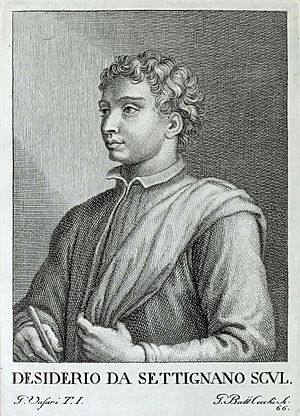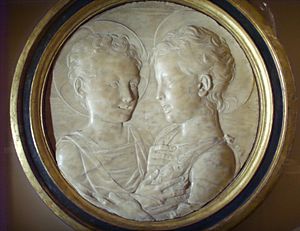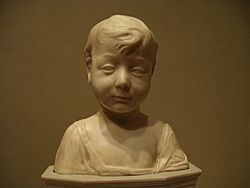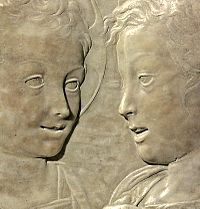Desiderio da Settignano facts for kids
Desiderio da Settignano, whose real name was Desiderio de Bartolomeo di Francesco detto Ferro (born around 1428 or 1430 – died in 1464), was a famous Italian Renaissance sculptor. He worked in northern Italy and was known for his beautiful marble sculptures.
Contents
Who Was Desiderio?
Desiderio came from a family of stone carvers in Settignano, a town near Florence. His work shows the influence of Donatello, another great sculptor. Desiderio likely learned his skills in a large workshop in Florence. This workshop was run by Bernardo and Antonio Rossellino.
In 1453, Desiderio joined Florence's guild for stone and woodworkers. Soon after, he began creating small angel head decorations. These were for the frieze (a decorative band) on the Pazzi Chapel. This chapel is part of the Basilica of Santa Croce in Florence.
Creating Important Tombs
It's quite amazing that Desiderio received a big job so early in his career. This was to create the large tomb for Carlo Marsuppini. Marsuppini was an important leader in Florence. Desiderio's talent for design and working with marble was clearly recognized.
For Marsuppini's tomb in Santa Croce, Desiderio looked at an earlier tomb. This was the Tomb of Leonardo Bruni, made by Bernardo Rossellino. Marsuppini had taken over Bruni's job as a state leader. So, it made sense for Desiderio to follow Bernardo's example.
Desiderio used the main idea of the Bruni tomb. This included a raised arch with a sarcophagus (stone coffin) and a statue of the person. But Desiderio made his tomb much more decorative and lively. He added children holding shields next to the sarcophagus. He also carved long garlands and running youths.
Inside the tomb's main area, Desiderio used four panels instead of three. This was unusual because three often stood for the Trinity. He also tilted Marsuppini's statue forward. This made the important scholar easier to see. The tomb's decorations were inspired by classical art. They made the tomb feel light and charming.
The San Lorenzo Tabernacle
In 1461, Desiderio finished a tabernacle for the San Lorenzo church in Florence. A tabernacle is a special place to keep the Eucharist (a religious item). This one was likely first placed in the main chapel choir.
For this Tabernacle of the Sacrament, Desiderio again used an idea from Bernardo Rossellino. He was inspired by a tabernacle Bernardo made around 1450. Desiderio's tabernacle is one of the most beautiful early Renaissance sculptures. It has columns framing a space that seems to go deep inside. This leads your eye to the actual door of the sacred closet.
Above this, there is a figure of God or Christ. He is holding an open book. Inside the deep space, angels seem to fly in from the sides. Their clothes look like they are fluttering in the wind.
The top of the tabernacle has a blessing Christ Child. He stands on a chalice (a special cup) and is surrounded by bowing angels. Two more angels stand on either side, holding tall candlesticks. All of this rested on a base with a carving of the Lamentation. This scene shows people mourning Christ's body.
This scene of Christ's suffering was important. It showed that Christ's body formed the base for the Sacrament. The tabernacle was moved in 1677. It was taken apart and put back together in a different chapel. More recently, it has been moved again. Experts tried to put it back together how Desiderio originally wanted it.
Master of Low Reliefs
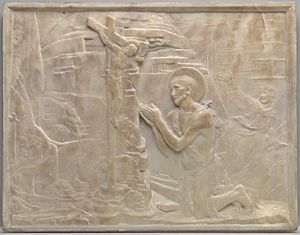
The Lamentation carving shows Desiderio's skill with low relief. This is a type of carving where the figures stick out only a little from the background. But his true mastery was in rilievo schiaccato. This means "flattened relief." He was almost as good as Donatello at this technique.
To see his "flattened relief" work, look at his Saint Jerome at Prayer in the Desert. This carving is so detailed it almost looks like a painting. Another example is his round carving (called a tondo) of The Meeting of Christ and John the Baptist as Youths. The faces of Christ and John in this tondo are very expressive. Raphael's father, Giovanni Santi, once called Desiderio "dreamy, so gentle and beautiful."
Most of Desiderio's other works are not clearly dated. So, experts guess when they were made based on their style. It's also debated how many works were made entirely by him. Many might have been done by his assistants or his brother Geri.
Sculpting Children and Portraits
Desiderio made big contributions to portrait sculpture. He was especially good at sculpting children. He almost "re-invented" this type of art. He was inspired by ancient Roman sculptures. His child sculptures look very natural and lively. They often have open mouths, making them seem real and immediate.
His name is also linked to several marble and wooden busts of women. A famous one is the marble bust of Marietta Strozzi in Berlin. It shows a soft, almost glowing beauty. It looks like the marble itself is shining from within.
Throughout his short career, Desiderio had a special skill. He could make his sculptures feel so real and soft that you wanted to touch them. He truly understood how marble could look bright and clear. He knew how a gently polished surface could create an inner glow. He also made Donatello's famous rilievo schiaccato even more refined. This made it look like light was softly spread through the air. Desiderio da Settignano was known for his gentle and subtle sculptures.
According to Giorgio Vasari, Desiderio's last work was a painted wooden statue of St. Mary Magdalene. He left it unfinished when he died. Another artist, Benedetto da Maiano, completed it.
Desiderio da Settignano died in Florence in 1464. One of his most famous students was Simone Ferrucci.
Selected Works
- The tomb of Carlo Marsuppini (1459) in Santa Croce, Florence
- Beauregard Madonna with Standing Christ Child (c. 1455) – marble relief, Norton Simon Museum, Pasadena
- A Little Boy (c. 1455–1460) – marble bust, National Gallery of Art Washington, DC
- The Virgin and Child (c. 1455–1460) – marble relief
- The Christ Child ? (c. 1460) – marble bust, National Gallery of Art, Washington, DC
- The Altar of the Sacrament in San Lorenzo, Florence (completed in 1461)
- Saint Jerome in the Desert (c. 1461) – marble relief, National Gallery of Art, Washington, DC
- Ciborium of the Sacrament, marble, National Gallery of Art, Washington, DC
- Madonna and Child in Swaddling Clothes, marble relief, Bargello Museum, Florence
- Bust of a Young Boy, (c. 1460), marble bust, J.Paul Getty Museum, Los Angeles
- Laughing Boy, (c. 1464), marble bust, Kunsthistorisches Museum, Vienna
- Julius Caesar in Profile,(c. 1460) marble high relief, Louvre Museum, Paris
- Marietta Strozzi, (c. 1460) marble bust, Staatliche Museen, Berlin
- Portrait of a Boy Looking Down, Bargello Museum, Florence
- Young John the Baptist, marble bust, Bargello Museum, Florence
- Jesus and John the Baptist, marble relief tondo, Louvre Museum, Paris
See also
 In Spanish: Desiderio da Settignano para niños
In Spanish: Desiderio da Settignano para niños
- Master of the Marble Madonnas


